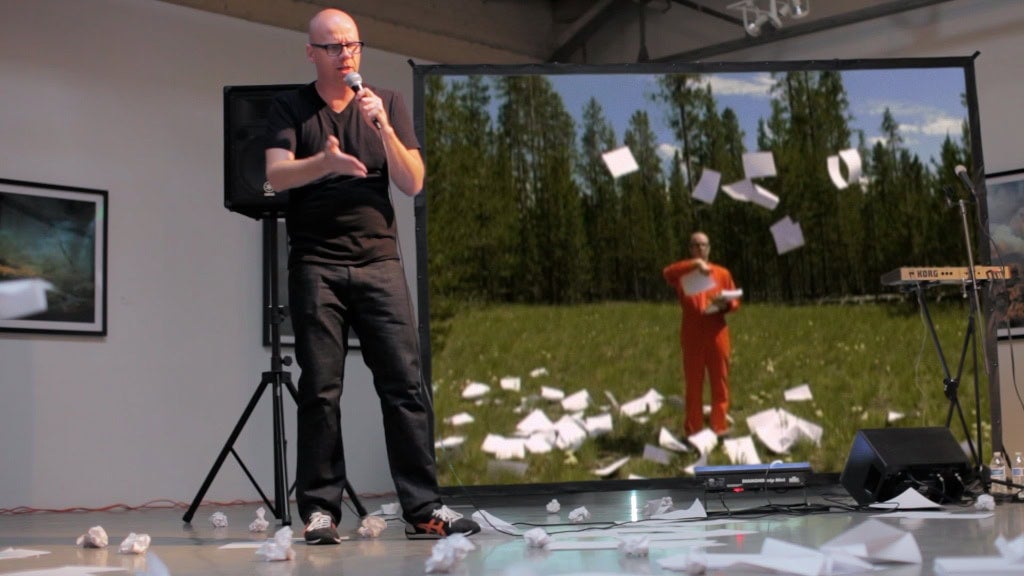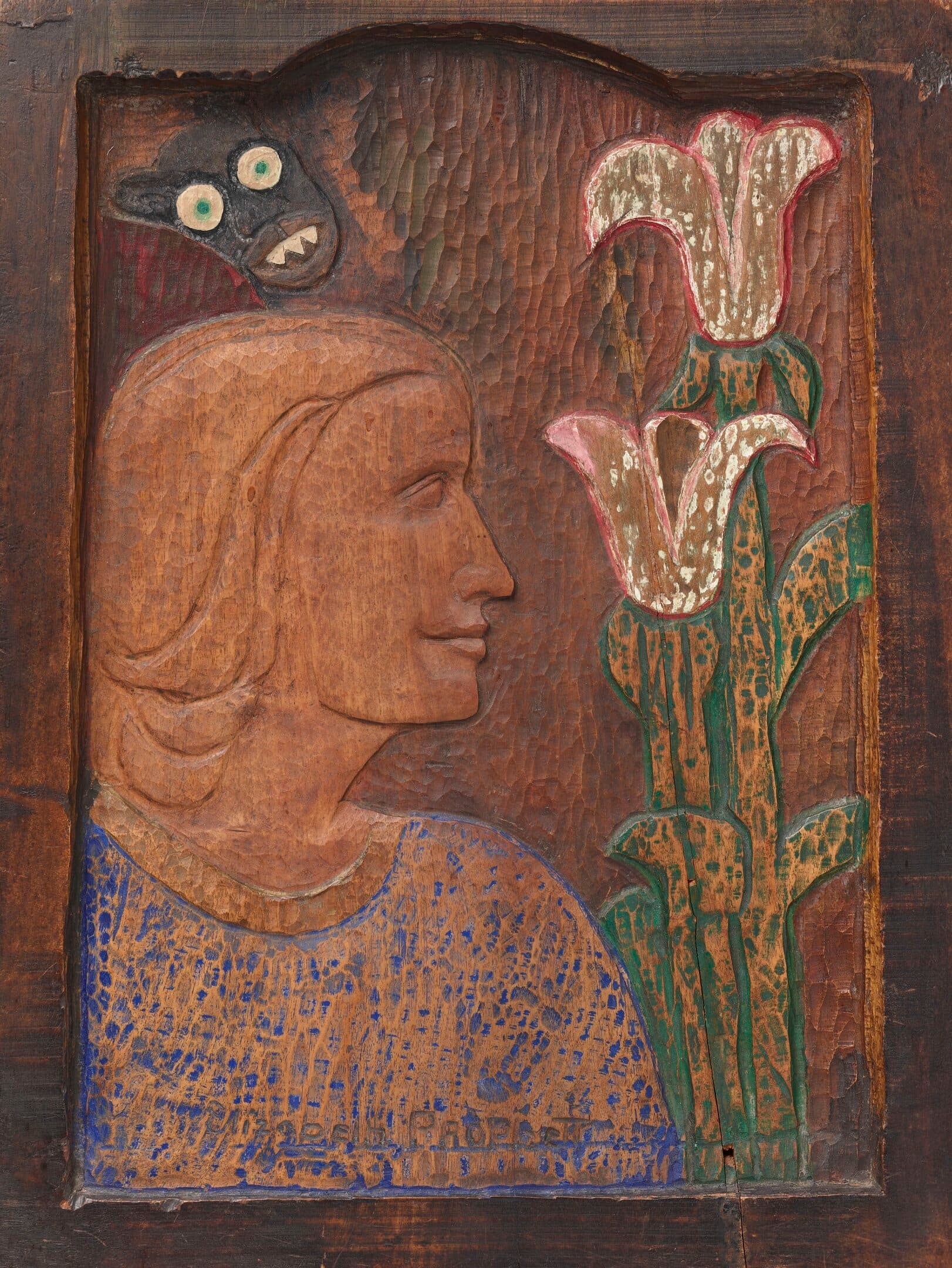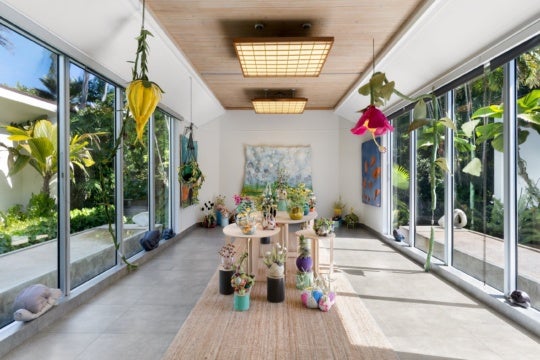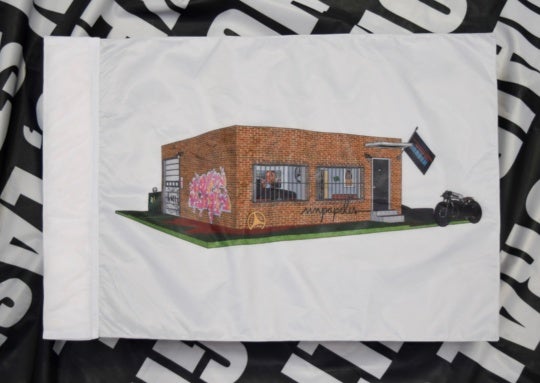
On February 17, Tucson-based artist Gary Setzer embarked on a two-month performance tour featuring his layered work The Black Tongue Lexicon, which incorporates sound, performance, and music with video projections. Setzer is an associate professor of art at the University of Arizona, and this tour will take him to universities and venues throughout the Southeast and other destinations nationwide. After touring, he will produce an EP album documenting his performance. I spoke with Setzer in advance of his February 17 visit to the College of Fine Arts at Jacksonville University in Jacksonville, Florida, the first stop on his tour, in order to explore his process and comparative interests surrounding the production of his works.
Lily Kuonen: According to your statement, you integrate performance art, video art, and live sound in The Black Tongue Lexicon. Performance art, especially process-based work, can sometimes require a calculated approach, and video can require post-editing. Can you describe your preliminary process of developing a layered work, and describe the arc it takes as it is refined for presentation?
Gary Setzer: Some components are absolutely calculated. While it may be contrary to myths we have about artists and creativity, I actually prefer systematic approaches. Often there are so many components to a singular work, I find myself making flow charts and spreadsheets just so I can keep track of what is done and what needs to be done. Grids are incredibly satisfying and a great metric for revealing whether or not you’re moving forward.
With that said, no matter how much I might prefer a formulaic approach, it rarely pans out that way. I trained as a painter and drawer—so I’ll often begin on paper, thinking about the body engrossed in an activity. Sometimes I’ll go into the landscape with my camera and a plan and then scrap the plan because it no longer feels right at the site. At that point, I’ll shoot from the hip, which isn’t guaranteed to succeed. However, I never feel like I’m spinning my tires, even when I invest time in preparatory work and it just falls flat. There is still a deep joy for me in preproduction, and whether the plan is executed successfully or not, I consider time spent thinking about the subject critical to the decision behind scrapping the plan in the first place. I always give myself ample time for failure. I enjoy the labor of it.
I think it’s important to be responsive to situations and to improvise—but doing that in front of an audience is something that I have very little interest in. Musically, I’ve never much cared for “jamming.” The very word conjures up visions of bongos, dormitory rooms, and acoustic guitars missing strings. Fun moments to live through, but not fun moments to live next door to, right? There are artists that do it well. I’m not one of them.
Sometimes the video comes first. Sometimes a passage of lyrics. Sometimes the beat. When one or more of these elements begins to feel refined, I start folding them together. That often means having to reshoot the video to match the timing of the audio, or extending the audio to match the action, etc. I think making art is grossly inefficient, no matter how I approach it; but I like to think that my propensity for over-organization is what allows these works take the form that they ultimately do.

LK: When I was first introduced to your video/performance and sound-based work, I experienced a strange feeling of familiarity. I knew logically that I had not seen your work before, but there was something I would call “neo-archetypal” about the way you combine moving imagery with electronic sound. How do you consider archetypes or associative pairings of imagery and language/sounds when developing your works?
GS: Music and the visual arts both formally incorporate harmony—but I think harmony can exist across sound and vision as well. It seems natural enough to me to parallel Donald Judd’s aesthetic rigor with the severe remove of a TR-808 drumbeat. Both gorgeously celebrate mathematical division. I think I push for that flavor of remove visually and aurally. I approach things in a subtractive manner, carving away until I leave only a few critical traces behind.
I had a professor in college that literally had me weeping when he was discussing one of Barnett Newman’s zip paintings in a lecture. A stripped down vertical line on a red field became a singular existential figure against the landscape—suddenly this line had all of the character of the monk in Caspar David Friedrich’s The Monk By the Sea. It was a transformative lecture. Friedrich and Newman were masters to me not because their paintings said, “Hey, look what I saw,” but rather because they were more inclusive, saying, “Hey, we see.” You are invited to become the monk in the fog, or the zip in the color field.
Similarly, I situate my body in the landscape metaphorically. In many ways the process-oriented tasks I undertake are diagrams. Repetitive actions, one-point perspective, symmetrical framing, the use of geometry, and a rudimentary color palette are all noise-filtering devices for me. They purport neutrality. Of course, nothing is neutral, but they quiet our mind enough to allow the visuals to become a skeleton for whatever other content is being communicated. I think this faux neutrality is absolutely a quest for the archetypal.
LK: You are about to embark on a two-month performance tour concluding with a residency at Brush Creek in Wyoming. Landscape plays an important role both physically and psychologically in your work. On tour, you will be presenting throughout a variety of different landscapes. How will this potentially alter or contribute to the content of your work?
GS: I wish that I could say that the landscape itself would impact my practice a great deal immediately, but I know myself better than that. I process very slowly, and am rarely reactionary. I will often nurture or toy with an idea or image for a couple of years before I recognize why it is critical. So I’ll have my eyes wide open driving through the country, but unfortunately all of those experiences will be thrown in the slow cooker. I’ll let you know in a few years.

LK: Do you view the tour as a possible workshop for the performance, to inform your creative process? Do you anticipate an evolution in the delivery of the performance over the two-month period?
GS: Yes, absolutely. It will change—I am sure of that. The more I perform works the more fluid and internalized they become. There is a threshold at which it becomes almost dissociative—where performing a segment becomes involuntary, like breathing, or pumping blood. It is both strange and beautiful. It’s as if the delivery of the lyrics becomes muscle memory—I can be immersed in reciting complicated lyrical passages and somehow transcend my conscious awareness of them. In fact, I may even start thinking about something altogether unrelated. I remember one specific summer evening in Ohio when I was a child. I was standing by an oak tree and I kept attempting to say two entirely different sentences simultaneously. Obviously, it didn’t work—I just kept saying the two sentences in rapid succession. But somehow it does work when I’m performing; my mouth can be speaking and my mind can be independently removed, focused on other thoughts.
Like my last body of work, these will ultimately be produced as an audio recording. I wanted to tour the project before I recorded it. It will help me find the real center of these new works.

LK: As an artist and an educator is it important to reach university audiences? Do you feel more comfortable in this setting, and do you feel like this environment has the possibility to foster critical dialogue with students? What do you bring back to your teaching practice from your experiences on tour?
GS: Performance art is a tough sell. It’s a relatively young medium compared to painting and sculpture and it’s still gaining its sea legs. That means there is a shit ton of bad performance art out there. The commercial gallery circuit has very little incentive to invest in performance art because there are frequently no salable objects. That’s not a critique of that model, it’s just a distinction; galleries depend on sales to keep their doors open. Likewise the juried show circuit often excludes live art for various practical reasons. So what are you left with?
Artist run spaces, alternative spaces, and universities are very performance friendly—but it frequently fits within the parameters of their core mission. My first two tours (2010 and 2011) were booked in artist-run and alternative spaces. Because I am a professor, I’ve not logistically been able to cross the country during the semester before, so the university gallery circuit was never a possibility. Now that I am on sabbatical, it seemed like a sensible thing to attempt.
Museums, alternative spaces, and universities definitely serve different cultural purposes. Museums often host what people already acknowledge to be art—it’s time-tested and already bears a certain gravitas. Alternative spaces tend to broaden that scope to include the margins. I’ve performed for audiences in both types of spaces, and I’ve noticed that the dynamic of the performance in the alternative space almost always feels electric. People have their guard down—art becomes a possibility, rather than an officially prescribed canon. I am interested to see where the dynamic lies with the university audience. My presumption is that it will be a very suitable audience for this type of work. Art students are still involved in their local music scenes—so both sides of my format will ring familiar within them.
LK: In The Black Tongue Lexicon you perform live in front of a video projection that also casts you as the main subject. Does this layered presentation of yourself draw parallels with trends in social media, like the “selfie?”

GS: I think that the audience will recognize that it is also me in the video projection, and I think that both bodies need to be me. But, I use my body as a body and not my body; I don’t really address the politics of the self—so there is no conscious reference to the “selfie.” In some ways, the live presence is narrating what is unfolding in the process-oriented video component—although not in the traditional sense of narration. Performance artist, Wynne Greenwood, writes about her interaction with her own projection (in her now defunct project Tracy + the Plastics) as an “interaction with a fragmented self.” She saw her use of multiple selves as an empowerment strategy in the face of marginalization. While my use of dual selves isn’t political, I have always identified with her notion of a fragmented self. I use the projection very consciously, dramatizing the mind/body split. My live presence deals with the theoretical, and my projected self deals with the physical application of that theory. The physical application is often appropriately ridiculous, and the physical endurance exerted can become comedic.
LK: By performing live you are directly engaging the audience. You talk about the audience’s experience in your statement, but I am more curious about how this direct engagement affects you while you are performing. Does an audience’s energy affect your work?
GS: Yes, absolutely. You can tell when the audience has joined you on that plane, and you end up performing a lot harder and dissolving into the work. The conditions have to be right, but when it happens it is delicious.
LK: Many elements of your work are stylized, both visually and acoustically. It appears as if you combine theatrical movements (maybe even a Brechtian Epic Theatre practice) with hip-hop and even phonetics. What sources do you cull? And, for that matter, what music do you listen to?
GS: On occasion my students will approach me and say, “Uh, professor … I saw you rapping online.” I grew up glued to Yo! MTV Raps, and my approach is informed by hip-hop, but I ultimately don’t consider the work part of the fiber of hip-hop. I acknowledge that I’m not singing—but I’m not rapping either—nor is it really spoken word. It’s kind of a paranoid talk-shout or attitude-driven lecture style that shares its roots with John Foxx, Gary Numan, or the Detroit group ADULT. The photographer Brian Ulrich recently compared my work to a blend of Public Image Limited, Thomas Dolby, and John Baldessari. I like that.
LK: Are there other artists/musicians/performers/or even linguists for that matter that you are interested in?
GS: A lot of my visual influences may be fairly obvious. Laurie Anderson, Joan Jonas, Bruce Nauman, Ann Hamilton, Janine Antoni, Yoko Ono, Matthew Barney, Tehching Hsieh, Wolfgang Laib, and Joseph Beuys. A lot of the process-oriented folks. Today Kate Gilmore, Vadim Zahharov, Tino Sehgal, Hayley Newman, Zhang Huan, and Erwin Wurm are all doing great things.
Musically, my favorite recent release is Recondite’s Hinterland. The Knife, LCD Soundsystem, Chromeo, Nite Jewel, Holy Ghost!, Matthew Dear, Neon Indian, Golab—there’s lots of great stuff out there. When I was a teenager Straight Out The Jungle by the Jungle Brothers made a huge impression on me. Afrika Baby Bam and Mike Gee were rhyming very straightforwardly about Afrocentrism and it was an “aha moment” for me. Suddenly, I saw music as this powerful vehicle for getting your message across.
LK: Also, these layers create a fiction. How does this fictional world clash or possibly balance the reality of live performance?
GS: I am glad that it reads as fiction. I hope that the projected video creates a postcard-like fictitious vista centered on our generic expectations about the idyllic. I believe that my role as a live performer is to continuously mediate the space between the audience and the video projection. In that way, I’m kind of a pesky narrator, calling upon the audience to dig deeper than the idyllic. Like my professor once was for me with the Barnett Newman painting.
Lily Kuonen lives in Jacksonville, FL, where she is assistant professor of art at Jacksonville University. She holds an MFA in painting from the Savannah College of Art and Design. Her work has been included in exhibitions at the Arlington Arts Center, the Cummer Museum of Art and Gardens, Herman Maril Gallery, and Boca Raton Museum of Art. Kuonen is a native of Arkansas, where she was born in the kitchen of her parents’ house.
Black Tongue Lexicon tour dates:
Jacksonville, FL
Jacksonville University
2/17/14 at 5PM
Greensboro, NC
UNC at Greensboro
2/18/14 at 7PM
Fredericksburg, VA
University of Mary Washington
2/20/14 @ 5PM
Towson, MD
Towson University
2/22/14 at 2PM
Philadelphia, PA
Arcadia University
2/24/14 at 7PM
State College, PA
Pennsylvania State University
2/25/14
Indiana, PA
Indiana University of Pennsylvania
2/26/14 at 5PM
Highland Heights, KY
Northern Kentucky University
2/27/14 at 5PM
Bowling Green, OH
Bowling Green State University
2/28/14 at 3:30PM
Iowa City, IA
P.S.1
3/5/14 at 7PM
Milwaukee, WI
University of Wisconsin-Milwaukee
3/6/14 at 4PM
Columbia, MO
University of Missouri
3/10/14
Cape Girardeau, MO
School of Art
Southeast Missouri State University
3/11/14 @ 6PM
Lexington, KY
Univeristy of Kentucky
3/12/14 at 5PM
Las Cruces, NM
New Mexico State University
3/18/14 at 6PM
El Cajon, CA
Grossmont College
3/26/14
Logan, UT
Utah State University
3/28/14 at 3PM




